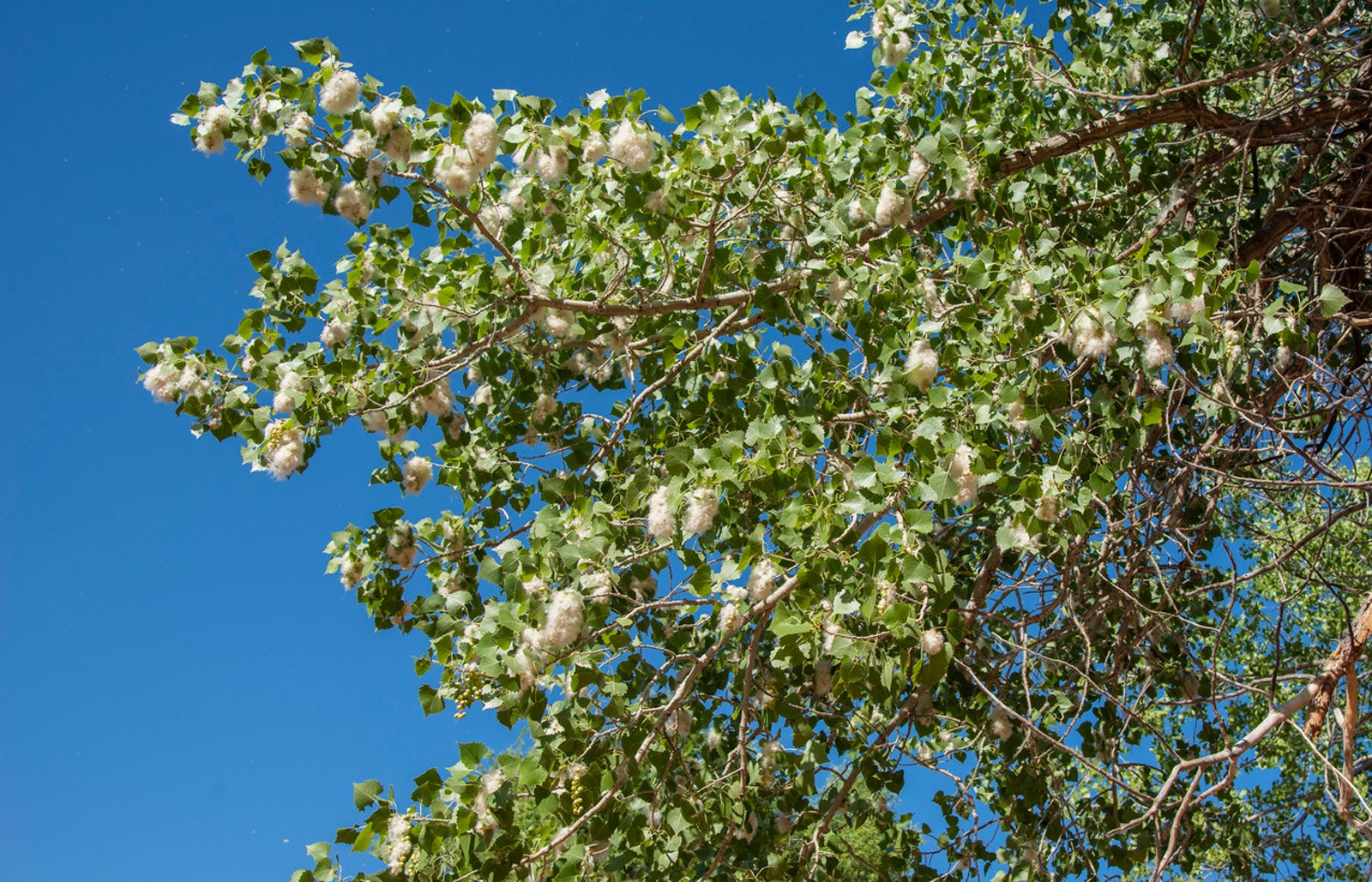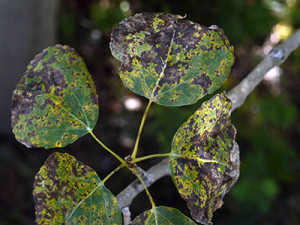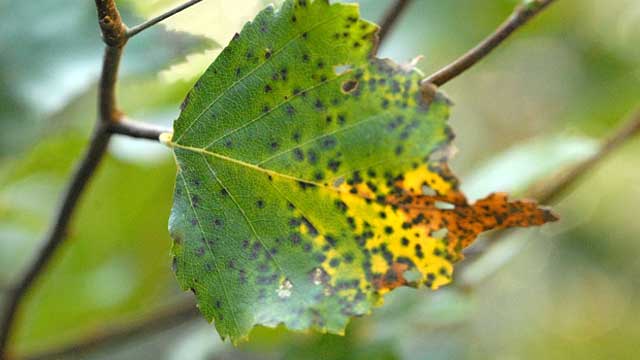cottonwood tree leaf disease
The lanceleaf cottonwood is a relatively high-maintenance tree so be prepared for pruning cleaning up seeds fruit and broken limbs and fighting off pests and diseases. Other poplars including hybrids are also susceptible to these two fungi.

Leaf Spot Diseases Of Trees And Shrubs Umn Extension
Cottonwoods are susceptible to a number of different diseases and insect infestations.
. Scale insects are not always recognizable as insects. Several fungi cause leaf diseases on cottonwood throughout its geographic range. This booklet will help forest nurserymen and plantation managers identify and.
Worse in years with wet springs. Dothichiza or Branch Canker. Scheduling and methods of irrigation.
Callus tissue may form. The lower branches can be pruned to allow pedestrians to pass beneath it. Leaves drop.
Cottonwood trees are also large shade trees and their sprawling branches have a spread of up to 113 ft. The disease causes dieback as the canker kills the bark and creates an oozing resin from the trunk. Cankers first appear as slightly sunken areas on the smooth bark of branches and trunks.
This tree leaves disease is usually caused by the Rhytisma fungi colonizing the maple family maple proper and sycamore. Huge host range. A common Cottonwood and Poplar tree disease is Cytospora Canker.
Especially if multiple of these signs are present at once your tree may already have died. The fungus attacks and kills the bark causing dead or dying areas called cankers. Leaf spot diseases may become epidemic during a wet spring and summer.
Quick facts Leaf spot diseases weaken trees and shrubs by interrupting photosynthesis. Cottonwood Tree Diseases Insect Infestations Cottonwood trees are a member of the poplar family. Opportunistic fungus attacks weak stressed.
Occidentalis infects black cottonwood. There are a number of borers which are attack cottonwood and elm. Leaf spots and blotches appear in the spring later for walnut often following leaf veins.
Leaf beetles are small less than 13 inch and chew on leaves causing the leaves to fade discolor and fall. Canker in cottonwoods can be easily identified by its sunken discolored areas of bark. Fungal disease caused by.
Silver Popular and Cotton Tree Care Issue Two Silver Poplar Tree Diseases. Insects and disease organisms are a continuing threat to cottonwood Populus deltoides Bartr especially during the trees first 5 years. Being a species of a poplar tree cottonwoods are also related to aspens.
Anthracnose Control high risk of spreading the fungal pathogen Identification On sycamore ash maple oak and walnut. Cytospora canker is the biggest invasive threat to cottonwood trees partially because the wood is already weaker than other types of trees. Dark sunken cracked cankers form on twigs trunks and branches.
Cottonwood leaf beetles are approximately 14 inch long and are pale. Cytospora canker is a tree disease caused by several species of Valsa and Leucostoma fungi. Signs of an infestation include shoots that turn black shrivel and then die.
The fungus attacks weakened trees affected by drought late-spring frosts insect and fungi defoliation or trunk and root injury. One key to diagnosis is that you will find the fungal growth on both the upper and lower surfaces of the affected leaves. Pick up know-how for tackling diseases pests and weeds.
Cankers may develop. Ag Economics Marketing. These trees grow quickly but they have shallow roots and are usually short-lived.
Some species of cottonwood trees have been known to reach heights of 100 ft. Plant Disease Clinic many other broadleaf trees. Are fairly host specific.
Rust of eastern cottonwood is caused by Melampsora medusae. 30 m or more. Trees - Freeze damage sunburn drought low fertility physical injuries etc.
Anthracnose caused by the fungal pathogen Apiognomonia veneta appears on Fremont cottonwood foliage as tan brown or black spots or irregular areas of dead tissue. The danger is intensified in large plantings of a single species and age because rapid buildup of damaging agents can occur. Most leaf spot diseases affect only a small percentage of the trees overall leaf area and are a minor stress on the.
15 24 m. Cottonwood and other poplars willows fruit trees elm conifers spruce pecan. Major cracks in the trunk of the tree.
Although the unsightly leaves and excessive leaf fall can be spectacular they usually cause only minimal growth loss. The symptoms start as yellow-green or light green spots in late spring-early summer with added tar-like formations by the late summer. Cottonwood Tree Diseases Insect Infestations Slime Flux.
Peeling bark in several areas at once. There are also signs however that the tree may have already died. Significant mushroom or other fungal growth near tree roots.
These large trees can grow to between 50 and 80 ft. Here is a link to the Texas Plant Disease Handbo0k information about cottonwood diseases. These pests can defoliate the cottonwood tree completely killing it but generally.
Cottonwood and Poplar Populus spp. Cottonwood is indeed susceptible to powdery mildew. Insects and disease organisms are a continuing threat to cottonwood Populus deltoides Bartr especially during the trees first 5 years.
The best time to prune a lanceleaf cottonwood tree is in late winter after the threat of freeze has. The larvae burrow into the phloem which can severely damage young or stressed trees. The danger is intensified in large plantings of a single species and age because rapid buildup of damaging agents can occur.
The cottonwood leaf beetle is 14-inch long. Two leaf rusts commonly attack cottonwoods in the United States. Leaf spot diseases should be taken seriously if they result in moderate to complete leaf.
Slime flux is also called wetwood. Its a fungus-based disease that affects stressed trees which would include cottonwoods that experienced a late frost. Find tactics for healthy livestock and sound forages.
Female and juvenile scales do not have wings legs. However Cytospora spp. It is caused by a bacterial infection that enters through wounds in the.
Insects Plant Disease. The beetle can completely defoliate a cottonwood tree. Farm bill farm marketing agribusiness webinars farm policy.
The fungus spreads across the living bark and wood of the tree. As with many diseases the best route of action is. Multiple branches with no living buds or leaves.

Black Leaf Spot Field Guide To Insects And Diseases Of Az And Nm Forests

Aspen And Poplar Leaf Spots 2 920 Extension

Leaf Spot Diseases Of Trees And Shrubs Umn Extension

Aspen And Poplar Leaf Spots 2 920 Extension
Signs And Symptoms Of Cytospora Canker Dieback In Cottonwood And Download Scientific Diagram
![]()
Leaf Spot Diseases Of Trees And Shrubs Umn Extension

Common Diseases Of The Fremont Cottonwood Tree Gardenologist
Cottonwood Tree Leaf Disease 349992 Ask Extension

Common Tree Disease Problems Symptoms And Photos Of Tree Disease

Cottonwood Tree Facts How Fast Does A Cottonwood Tree Grow

Colorado Master Gardener Fading Aspen Trees Steamboattoday Com

Aspen Cottonwood Leaf Diseases Not Lethal To Trees But Could Impact Fall Colors Colorado State Forest Service

Aspen Tree Fungus Prevention Control 720 248 0000

Common Tree Disease Problems Symptoms And Photos Of Tree Disease

Poplar Populus Spp Marssonina Leaf Spot Pacific Northwest Pest Management Handbooks
Diseases Of The Fremont Cottonwood Tree

Leaf Spot Diseases Of Trees And Shrubs Umn Extension

Diseases And Insect Infections To Watch For In Your Cottonwood And Elm Trees Tree Care Blog Boise Idaho Mountain West Arbor Care
